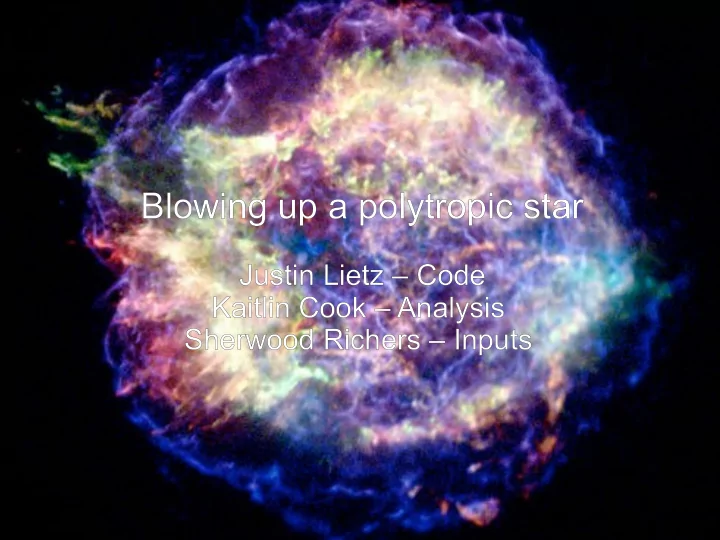

Blo lowin wing u up a a p polytr lytropic sta ic star Justin Lietz – Code Justin Lietz – Code Kaitlin Cook – Kaitlin Cook – Analysis Analysis Sherwood Richers – Inputs Sherwood Richers – Inputs
Motivations ● Toy model of a star + toy model of a shock = toy supernova. ● We can then follow the nucleosynthesis. ● Acts as a good way to combine the tools from last week.
Aims Lane Emden Sedov blast star Lagrangian VH1 Dimensionalise XNet
Key Challenges ● Working out units ● Recasting VH1 in Lagrangian coordinates ● Writing a wrapper script to take output from VH1 to XNet ● Displaying the results in a meaningful way
Polytropic Stars: Lane-Emden Solutions Plot of a solution to Lane-Emden n = 3/2 Poisson Equation: Hydrostatic Equilibrium: Polytropic EOS: Lane-Emden: Energy of the Blast = 10 49 Ergs
Sedov Blasts ● The Sedov blast - a large amount of energy in a small region. ● Very high pressure in the first zone, smaller pressures in all of the other zones (from star model)
Lagrangian Coordinates ● Eulerian coordinates – zones transfer matter ● Lagrangian coordinates – zones follow matter → Follow nucleosynthesis without advecting species
VH1 Lagrangian ● ppmlr.f90 Setup Eulerian Grid Map to Lagrangian Map to Lagrangian Evolve Evolve Remap to Eulerian Remap to Eulerian Setup Lagrangian Grid Evolve
Lagrangian vs Eulerian
Connecting VH1 to Xnet ● VH1 output looks familiar to a lot of you by now:
Hydro Results – 1 M sol + 10 49 ergs
10 M sol + 10 49 ergs
1 M sol Blast at different radii
Nucleosynthesis 1 M sol + 10 49 ergs 0.03 R sol – Peak T = 3.3 GK
Nucleosynthesis 1 M sol + 10 49 ergs 0.10 Rsol– Peak T = 0.04 GK
Nucleosynthesis 1 M sol + 10 49 ergs 0.17 Rsol – Peak T = 0.001 GK
50/50 n/p progenitor
4 He progenitor
56 Fe progenitor
Abundances at t = 10 5 n+p initial 4 He initial 56 Fe initial
With a few more days? ● Add in gravity ● Realistic EOS ● Realistic initial conditions for hydro ● Further variation of initial abundances ● Larger Network ● Vary blast energy ● Nucleosynthesis on all zones ● Feed the Nucleosynthesis energy into the hydro
Recommend
More recommend